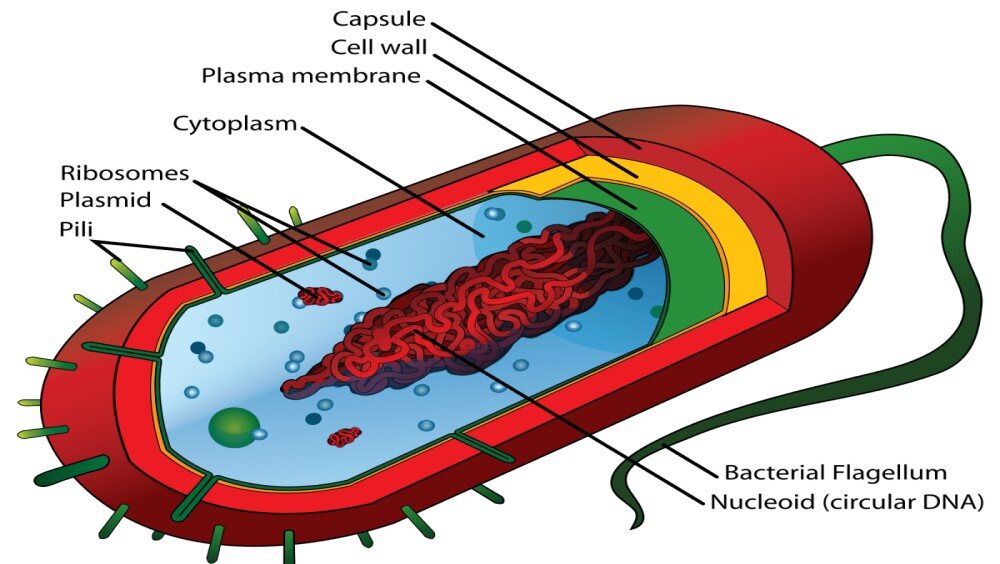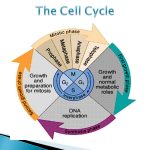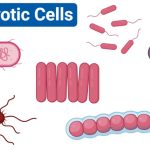Prokaryotic Cell Definition
Prokaryotic cells are cells that do not have a true nucleus or membrane-bound organelles. Organisms within the domains Bacteria and Archaea have prokaryotic cells, while other forms of life are eukaryotic. However, organisms with prokaryotic cells are abundant and make up much of Earth’s biomass.
Prokaryotic Cell Overview
Organisms that have prokaryotic cells are unicellular and are called prokaryotes. Prokaryotic cells can be contrasted with eukaryotic cells, which are more complex. Eukaryotic cells have a nucleus surrounded by a nuclear membrane and also have other organelles that perform specific functions in the cell. A prokaryotic cell contains only a single membrane, which surrounds the cell as an outer membrane.
All of the reactions within a prokaryote, therefore, take place within the cytoplasm of the cell. While this makes the cells slightly less efficient, prokaryotic cells still have a remarkable reproductive capacity. A prokaryote reproduces through binary fission, a process which simply splits duplicated DNA into separate cells. Without any organelles or complex chromosomes to reproduce, most prokaryotic cells can divide every 24 hours, or even faster with an adequate supply of food.
While many prokaryotic cells have adapted to free-living within the environment, many more have adapted to live within the gut of other organisms. These commensal organisms survive by breaking down molecules inside the gut and allow the organism they are living within the ability to digest a wider variety of foods. For example, the human gut contains 2-3 pounds of bacteria, which have evolved to help us digest complex carbohydrates, proteins, and fats.
Examples of Prokaryotic Cells
Bacterial Cells
Bacteria are single-celled microorganisms that are found nearly everywhere on Earth, and they are very diverse in their shapes and structures. There are about 5×1030 bacteria living on Earth, including in our own bodies; in the human gut, bacteria outnumber human cells 10:1.
The cell walls of bacteria contain peptidoglycan, a molecule made of sugars and amino acids that gives the cell wall its structure and is thicker in some bacteria than others. Bacteria contain certain structures unique to them as previously mentioned, such as the capsule, flagella, and pili. Most bacteria have just one chromosome that is circular, which can range from about 160,000 base pairs (bp) to 12,200,000 bp. They also contain plasmids, which are small circular pieces of DNA that replicate independently of the chromosome.
Some bacteria can form endospores. These are tough, dormant structures that the bacteria can reduce themselves to under starvation conditions when not enough nutrients are available. They do not need nutrients and are resistant to extreme temperatures, UV rays, and chemicals. When environmental conditions become favorable again, the endospore can reactivate.
Archaeal Cells
Archaea are similar in size and shape to bacteria, and they are also unicellular. Since bacteria and archaea are the two types of prokaryotes, this means that all prokaryotes are unicellular. Some archaea are found in extreme environments, such as hot springs, but they can be found in a variety of locations, such as soils, oceans, marshlands, and inside other organisms, including humans.
Like bacteria, archaea can have a cell wall and flagella. However, the structure of these organelles is different. For example, archaeal cell walls do not contain peptidoglycan. In addition, the flagella of archaea work the same way as those of bacteria, but they evolved from different structures. Membranes of archaea are very different than those of all other lifeforms; they contain different lipids, which have a different stereochemistry. Archaea usually have one circular chromosome, as bacteria do. The archaeal chromosome can range from less than 491,000 bp to about 5,700,000 bp. They can also contain plasmids. Less is known about archaea than bacteria; they were not classified as a separate group of prokaryotes until 1977.
Prokaryotic Cell Structure
Prokaryotic cells do not have a true nucleus that contains their genetic material as eukaryotic cells do. Instead, prokaryotic cells have a nucleoid region, which is an irregularly-shaped region that contains the cell’s DNA and is not surrounded by a nuclear envelope. Some other parts of prokaryotic cells are similar to those in eukaryotic cells, such as a cell wall surrounding the cell (which is also found in plant cells, although it has a different composition).
Like eukaryotic cells, prokaryotic cells have cytoplasm, a gel-like substance that makes up the “filling” of the cell, and a cytoskeleton that holds components of the cell in place. Both prokaryotic cells and eukaryotic cells have ribosomes, which are organelles that produce proteins, and vacuoles, small spaces in cells that store nutrients and help eliminate waste.
Some prokaryotic cells have flagella, which are tail-like structures that enable the organism to move around. They may also have pili, small hair-like structures that help bacteria adhere to surfaces and can allow DNA to be transferred between two prokaryotic cells in a process known as conjugation. Another part that is found in some bacteria is the capsule. The capsule is a sticky layer of carbohydrates that helps the bacterium adhere to surfaces in its surroundings.
Prokaryotic Cell Diagram
The following image is a diagram of a prokaryotic cell; in this case, a bacterium.


